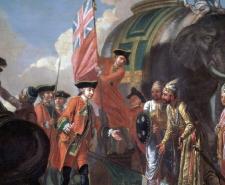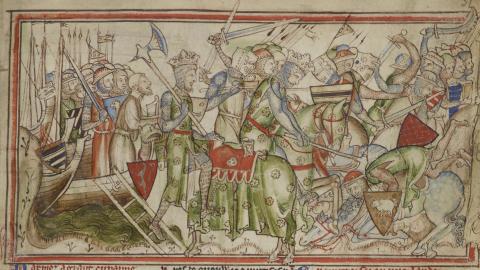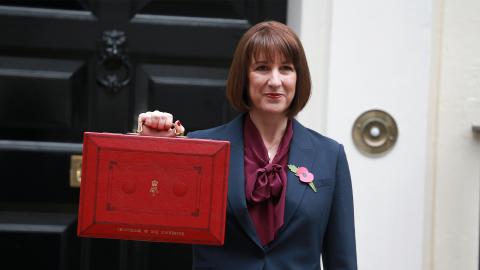
The rise and fall of the East India Company
Image: Flag and illustrations of the British East India Company | Public Domain
In Al Murray: Why Does Everyone Hate the British Empire?, comedian and historian Al Murray travels to India, Jamaica, South Africa and Australia to learn about the origins of British rule, its impact upon each country and its legacy. The show is now available on catch up.
Today, Walmart is the biggest corporation in the world. Imagine, if you will, that in addition to making money from its global retail operation, Walmart was also the ruler of a country, collected taxes from millions of people and maintained a standing army of a quarter of a million men. The idea is absurd, and yet, that’s exactly the position the East India Company found itself in in the 18th and 19th centuries. But how?
Humble beginnings
The year was 1599 and a group of English businessmen and adventurers gathered together in London. They agreed to form a company to exploit the growing demand for goods such as textiles and spices coming from the East Indies, in particular India and parts of Southeast Asia. The aim was to get a royal charter from Queen Elizabeth I that would grant them the exclusive rights to trade with the East. In 1600, the charter was granted and the East India Company came into being.
Eight years after gaining its charter, the East India Company founded its first permanent settlement in India - Fort St. George on the Bay of Bengal. At the time, England was just one of several European countries vying to dominate trade with the East Indies. England’s main competitors were the Netherlands and France, both of which established trading posts on the subcontinent. It remained to be seen who of the three would win the race to exploit the fabulous wealth of what was then the largest economy in the world.
Expansion
Following the establishment of Fort St. George, the company was keen to expand operations as its coffers began to fill up from its Bengal operation. The turning point came in 1613 when the company obtained a permit from the Mughal Emperor Nur-ud-din Salim Jahangir to open a factory in the Mughal city of Surat. The establishment of this new trading post further cemented the company's grip on trade in the region.
After Surat, the East India Company continued to expand its operations across India throughout the 17th century and into the 18th. Times were good and the profits were rolling in, but what turned a trading company into the biggest, most powerful corporation on the planet and a de facto sovereign state?
Firstly, the company became very adept at forming alliances and backing the right horse. The East India Company started to take sides with one local ruler over another when provinces it was interested in expanding into went to war. In return for their support, the company was rewarded with more contracts and more opportunities. The East India Company had gone into the diplomacy game, and it proved remarkably good at it.
Secondly, the company’s main rivals, France and the Netherlands, were eventually pushed out of the subcontinent except for a handful of mostly irrelevant trading settlements. The Netherlands pretty much bowed out of India following the Glorious Revolution of 1688 and the appointment of Dutchman William of Orange as the new King of England. Now allies, England focussed its efforts on protecting and exploiting its Indian interests, while the Dutch increasingly turned their attention to exploiting the spice trade of the Far East. England’s only other serious rival, France, was knocked out of the game when she and her ally Spain lost the Seven Years War of the 1750s and 1760s. With no rivals left on the board, the East India Company could now focus on the next phase of their corporate expansion - rule.
Rulers of India
By the 1750s, the East India Company had its own private army, and it was this army, under the command of Robert Clive, that defeated the Nawab of Bengal at the Battle of Plassey in 1757. Following Clive’s victory, Bengal came under company control. It now had the power to raise taxes from millions of people and this marked the start of an expansion that would eventually see the company rule India.
One by one, the company’s armies - made up of enlisted men from Britain and native regiments known as ‘sepoys’ - scored victory after victory over the country’s network of regional rulers. The four Anglo-Mysore wars during the last three decades of the 18th century saw the company take control of most of the subcontinent, and the Anglo-Sikh wars of the 1840s brought the Punjab and its fearsome warriors under the company’s wing. By the 1850s, the East India Company was the ruler of India. Any threat to the company’s dominance was kept at bay by Britain’s vast, nigh-on unbeatable Royal Navy. It seemed that the company was unstoppable. Trouble, however, was on the horizon.
Downfall
The end of the East India Company came not from defeat on the battlefield, but from within the ranks of ‘John Company’, its native army of Hindus, Sikhs and Muslims. In 1857, a rumour began doing the rounds that a new type of rifle cartridge was about to be foisted on the troops that were greased with forbidden pork and cow fat. Before long, the company’s troops were in open rebellion, killing British officers and their families, burning their homes to the ground and rampaging across the countryside. The Indian Mutiny could have toppled the company had it not been brutally brought under control by the British.
After the rebellion was quashed, it was concluded in London that India must come under direct British rule. In 1858, Britain took over the government of the subcontinent, bringing an end to 100 years of company control, and marking the start of the ‘Jewel in the Crown’ of the British Empire - the British Raj. The East India Company limped on for a few more years before finally being wound up on 1st June 1874.
‘It accomplished a work such as in the whole history of the human race no other trading Company ever attempted,’ said The Times of London as the company was in its death throes, ‘and such as none, surely, is likely to attempt in the years to come.’
Facts about the East India Company
- The British government granted the company the right to sell Chinese tea in America without paying the same taxes other exporters were forced to pay. The outrage this caused amongst colonists led to the Boston Tea Party, which in turn sparked the American War of Independence.
- The company’s involvement in the Chinese opium trade led to the two Opium Wars of the 1830s and the 1850s. When China decided to ban opium and destroy the company’s stocks, the British government sent a naval expedition to force the Chinese to pay reparations and keep the trade open. The second war, waged against China by Britain and France, led to the legalisation of opium - something which China is still understandably angry about to this day.
- The biggest blot in the company’s copybook is the Great Bengal Famine of 1770. The company, in charge of Bengal at the time following its victory at Plassey in 1757, bought up most of the region’s rice supplies for its troops and refused to lower taxes, both of which were major contributing factors in the deaths of between eight and ten million people.



















